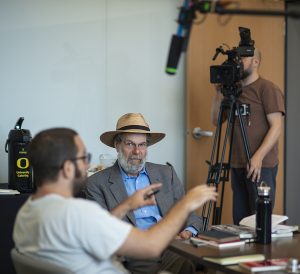A movement needs to be followed. For slow news to spread beyond the confines of isolated thought, ideas need to be exchanged and passed on. The University of Oregon is currently researching and even teaching slow news.
“The role of slow news at the university is part of our academic curriculum to teach good journalism and to figure out ways to get off the addiction of the 24-hour news cycle,” said the James Wallace Chair in Journalism at the University of Oregon, Peter Laufer.
There are instances where the news media are expected to respond with expediency—namely, breaking news events. And there is value to breaking news reporting when those reports can warn people of immediate threats to their lives. But for all good breaking news reports can herald, there is a degree of harm that can be caused by journalist in the chaos of the first 24 hours.
Lori Shontz, professor at the School of Journalism and Communication, has been researching the effects of news media on mass shootings. Her goal is to develop curriculum and training to better prepare journalists who report on mass casualty events.
Interviewing trauma victims not only provides unreliable information, but can be damaging psychologically for the victim.

Lori Shontz specializes in the teaching of core writing and reporting skills. She co-directs Writing Central, the SOJC’s peer writing support program, and is a leader nationally in the teaching of engaged journalism.
“What I’m learning is that trauma victims have tricky memories and that they don’t always remember everything that happened in clarity,” Shontz said. “It’s not the same as interviewing somebody else but we treat it like it is.”
Where there is mass casualty, there will be a mass journalists. The sudden influx of reporters can put more strain on an already grieving community. Dallas News Reporter, Lauren McGaughy, wrote an op-ed apologizing for the invasion of journalist after the Sutherland Springs Shooting.
“When there’s breaking news, we show up, we report it, and the people get tired of us and we leave.” Shontz said, “We don’t continue to go back after we show up.”
SOJC professor Nicole Dahmen is researching ways of taking breaking news coverage beyond the initial shock and awe by looking at images of resistance, recovery, and resilience. Dahmen said we need images that portray the reality of a breaking news situation, that portray the horrors of war and tragedy but that “these images need not be the entirety of our news media coverage.”
In 2016, Tavon Tanner became one of 24 children younger than 12-years-old to be shot in Chicago. Photographer E. Jason Wambsgans of the Chicago Tribune won a Pulitzer Prize for his coverage of Tavon’s recovery.

Nicole Smith Dahmen is an Associate Professor at the School of Journalism and Communication at the University of Oregon. Her research focuses on ethical and technological issues in visual communication, with an emphasis on photojournalism in the Digital Age.
“These images absolutely illustrate that this slow news approach from a photographic perspective can absolutely provide us information and effectively report on the reality of gun violence and mass shootings,” Dahmen said. “These photographs do something in a way, in telling us this story, that breaking news absolutely cannot do.”
While the gun debate will remain controversial in the U.S. other issues may find resolutions through Solutions Journalism. Solutions Journalism is reporting on responses to social issues. Instead of looking at cities with worst crime rate, Solutions Journalism looks at a city that lowered its crime rate, and how.
“Most journalism focuses on the who, what, and when,” said SOJC professor Kathryn Their. “We don’t really focus on the ‘how’ quality that often in journalism, and solutions journalism is never breaking news it’s always retrospective and it really delves deeply, deeply into that how.”

Kathryn Thier is a nationally recognized instructor of solutions journalism and co-founder and co-director of The Catalyst Journalism Project, a research and teaching collaborative focused on the intersection of solutions journalism and investigative reporting funded by The Solutions Journalism Network and the University of Oregon.
Thier and Dahmen oversee the Catalyst Project at the University of Oregon. The Catalyst project combines traditional investigative stories with solutions stories. Instead of simply highlighting wrongdoings or flaws, the Catalyst Project delivers a one-two punch that offers corrective measures.
“It’s very hard for government officials to say ‘this problem is just too big and bad to do anything about’ when you point out that somebody, somewhere is actually doing something about it,” Thier said.
Solutions Journalism is not public relations. Stories do not focus solely on a hero and must include limitations. The stories must serve democracy.
“we need to arm students with not just new skills but ideas about how journalism might need to change in service of democracy,” Thier said.


 Slow News
Slow News